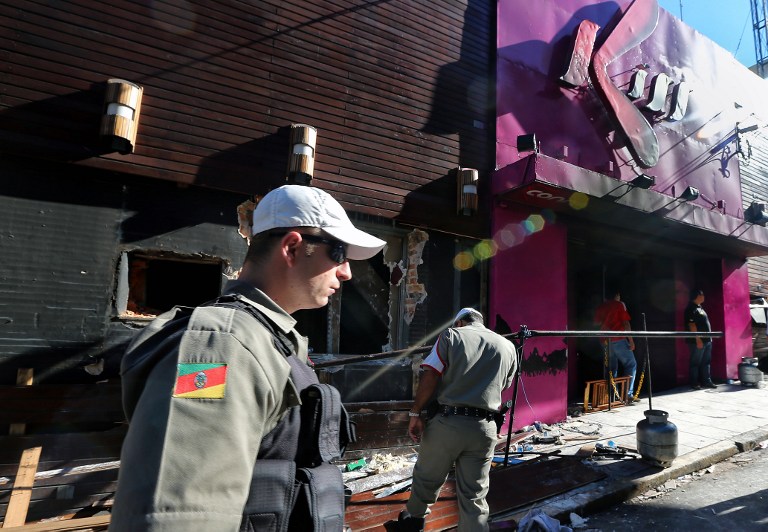SUMMARY
This is AI generated summarization, which may have errors. For context, always refer to the full article.

SANTA MARIA, Brazil – A police probe into a nightclub fire in Brazil that killed 234 people and left dozens in critical condition turned Tuesday, January 29, to whether key evidence has been hidden.
Authorities have taken four suspects into custody following the tragedy early Sunday, January 27, at the Kiss discotheque in the southern college town of Santa Maria, described as the second worst inferno in the country’s history.
Those detained Monday, January 28, include two owners of the club and a pair of musicians who allegedly took part in an ill-fated pyrotechnic show being blamed for sparking the blaze.
But with many questions still unanswered, police were investigating whether security cameras recorded what happened and whether the place — packed with university students — was overcrowded.
“The video cameras weren’t in the nightclub (where they were supposed to be) and there was no computer with memory for storage,” prosecutor Veruska Agostine told reporters.
The owners of the club, meanwhile, contend the surveillance system had not been working for two months.
Some survivors claimed the vocalist of the Gurizada Fandangueira band lit a firework that may have triggered the blaze, which broke out at around 2:00 am (0400 GMT) Sunday. Police were trying to pinpoint who brought the fireworks to the club and activated them.
The drama was caused by “the use of fireworks in a closed space” where there were “too many people,” Major Jerson da Rosa Pereira of Santa Maria’s fire department told AFP.
There were “locked doors at the time of the evacuation,” he added.
The club, which was open despite an expired license, had only one working exit that, according to survivors, was unmarked and blocked by steel barriers, which made it difficult to get out.
Some 180 bodies were found in the bathrooms, which many panicked party-goers had apparently confused with emergency exits.
Some survivors also said that, initially, security guards blocked the exit in an attempt to keep people from leaving without paying. In addition, at least one fire extinguisher allegedly did not work properly.
Most of the victims died of smoke inhalation in their desperate bid to escape in a haze of toxic black smoke.
Police also were searching for the club’s cash register, which could help determine whether the establishment was overcrowded.
Health Minister Alexandre Padilha confirmed the death toll has risen from 231 to 234, while 75 people remain in intensive care in serious condition.
The state of Rio Grande do Sul, where Santa Maria is located, has moved to freeze assets of both the club owners and their company.
“The aim is to ensure the right of people to guaranteed compensation,” said the state’s attorney general, Nilton Arnecke Maria.
Late Monday, 15,000 people marched through Santa Maria, demanding justice for the dead as anger mounted.
“I know that my daughter isn’t coming back. But somebody has to pay for this,” said marcher Jorge Neves, who lost his daughter Rafaella.
Meanwhile, mayors of several cities announced more stringent oversight of nightclubs during their annual meeting with President Dilma Rousseff, who urged them to ensure that such a “terrible tragedy never takes place again.”
The massive South American nation is observing three days of mourning as distraught families and friends continue to bid farewell to the victims as others clung to life.
Mario Birnfeld do Canto, a doctor at the private Caridade Hospital, went through one of the cruelest twists of fate: having to treat his own 18-year-old daughter, Mariana, after the tragedy.
“I never have seen anything like this. Almost 300 young people piled up and suffocated to death. We as a Brazilian society cannot allow this to happen, for 300 kids to die like that.
“They all died of asphyxiation because there was not enough rigor by the people running this country,” the doctor said, right after picking up Mariana’s death certificate. – Rappler.com
Add a comment
How does this make you feel?
There are no comments yet. Add your comment to start the conversation.